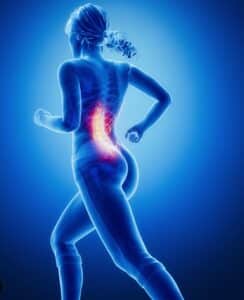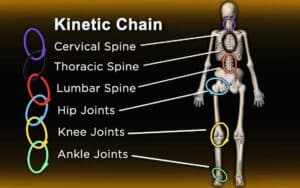By Sumaiya Farheen and Andrew Siyabalawatte, Sept 2023.
In a world where seconds tick like a metronome, there unfolds a graceful performance that resists the relentless advance of time. It’s not just about pounding the pavement, it’s about finding the rhythm, balance, and harmony that keep us moving forward, regardless of our age.

In this blog, we’ll explore how the spine serves as the chain link in this performance, and how the simple act of breathing can produce profound effects on our physical and mental well-being.
The Rhythm of Running

Running is more than just a physical activity, Imagine your feet as drumbeats, creating a rhythm that resonates with the world around you. The act of running itself is a balance between pushing forward and staying grounded, much like a tightrope walker navigating their thin line.
Try to concentrate on your technique, the way your foot strikes the surface, your stride length, and the way your back is being held. All three will help you find a running rhythm that works well for you which will result in a better running performance, faster speeds and greater endurance. In turn, this will enable you to run for longer periods of time.
Run To The Rhythm Of The Music
The tempo of music creates a repetitive rhythm which can determine the speed at which you run. The slower the music, the slower your run, the faster the music, the faster you run. Switch your playlist according to the speed you want.
Balance: The Art of Staying Upright

Balance is the invisible thread that ties the rhythm of life together. It’s the delicate equilibrium between forward motion and staying grounded. As we age, our bodies undergo changes, challenging this equilibrium. Balance harmonizes life’s complex aspects- health, wealth, social ties, spirituality, and the work-family equilibrium. Adapting to life’s changes, we craft this balance artfully with mindfulness and purpose, creating a harmonious life.
Harmony: The Key to Endurance

Harmony in running means synchronizing your body and mind. It’s about finding that sweet spot where effort feels effortless. Rhythmic breathing using our diaphragm, is a powerful tool to get more oxygen and reduce the impact of running on your body. This harmony, often elusive but oh so rewarding, becomes increasingly valuable as we age. It allows us to preserve energy, prevent injuries, and keep our love for running burning bright.
By using belly and rhythmic breathing, your breathing can become more efficient during your run, helping you run for longer. Read our article on the effect of improper breathing to find out more!
The Spine: Your Chain Link to It All

At the heart of this dance is the spine—the body’s central chain link. It’s the pillar that supports our every move, whether we’re sprinting or taking a leisurely jog. Your spine isn’t just a stack of bones; it’s the conductor of your body. A well-aligned spine ensures that your body moves efficiently, reducing the risk of injury and allowing you to run with grace.
Keep Your Chains Well-Oiled
We have three primary chains.
1. the kinetic, 2. the spiral and 3. the vertical.
The Kinetic chain, governs movement, and is simply the chain which propels us forward and backwards, just in the action of running. It is the most powerful of the chains. The big front muscles of the chest and abdomen and strong muscles in the lower back, buttocks and thighs, lets us explode forward against resistance (wind, gravity, weight) until we gain momentum.
The Spiral chain on the other hand, focuses on stabilising the body during such movements. Muscles of the front of the body in the spiral chain include the serratus anterior, internal and external obliques, Tensor fascia lata (known as the TFL), and the lower leg muscles of the tibialis anterior and the peroneal groups.
The spiral chain of the back of the body include, the erector spinae (main back of spine muscles) the thoracolumbar fascia (a band of tissue connecting the upper back to the lower back), the rhomboids (inner shoulder blades) and the splenius capitis (a muscle which attaches to our skull).
Without the muscles listed above, we would not be able to keep our trunk steady.
Finally, the third and possibly the most important, – the vertical chain. This chain, functions by stabilising the body at rest. Muscles involved include, the calf muscles, the hamstrings, the hip flexors, the quadratus lumborum and the erector spinae (which you already know as the back of spine muscles)
Without this chain, we would collapse to one side.
How do our muscle and fascial chains affect the back? Listen to our thought for the day to find out how.
Age with Grace

As time passes, we may face circumstances that challenge our strength. But remember, the symphony of running is ageless. By nurturing your spine, perfecting your breath, and allowing the rhythm to guide you, you can continue to dance through life’s challenges with grace and confidence.
Here are a few tips-
Listen to Your Body- Tune in to your body’s signals. If something doesn’t feel right, adjust your routine accordingly. Rest and recovery become even more crucial as we age.
Diversify Your Training- Mix in strength training, flexibility exercises, and cross-training to support your running. A holistic approach can help maintain balance and harmony.
Stay Mindful- Running can be a meditation. Use this time to reflect, find inspiration, and cultivate gratitude for the journey, no matter your age.
Seek Professional Guidance- If you encounter specific challenges or injuries, consult with physical therapist who can provide tailored advice.
Running is more than just a physical activity, it’s a profound affirmation of our existence. It highlights the intricate bonds between balance, harmony, our resilient spine, and the transformative influence of our breath.
So, as you get ready for your next run, keep this in mind: it’s not a race against time; it’s a harmonious dance with it. It’s an opportunity to discover grace and wisdom in every step, to warmly embrace the natural changes life offers, and to care for the precious instrument that is your spine.

